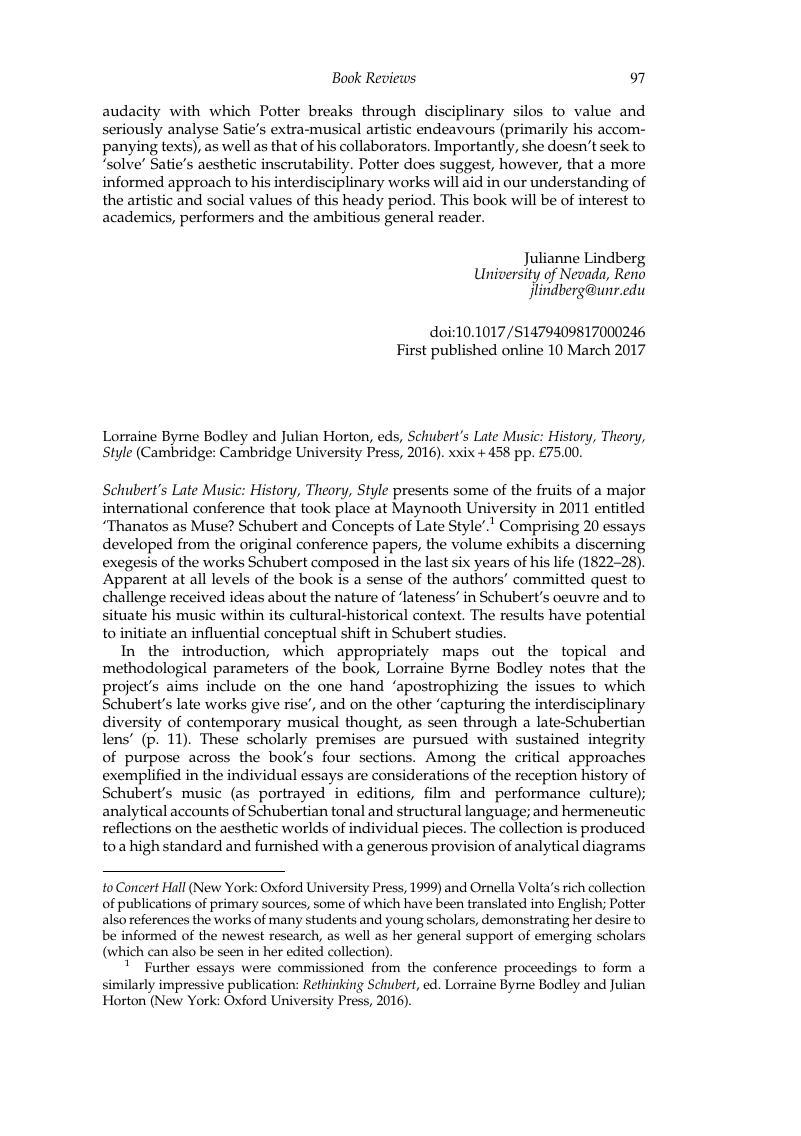No CrossRef data available.
Article contents
Lorraine Byrne Bodley and Julian Horton, eds, Schubert’s Late Music: History, Theory, Style(Cambridge: Cambridge University Press, 2016). xxix+458 pp. £75.00.
Review products
Published online by Cambridge University Press: 20 November 2017
Abstract

- Type
- Book Reviews
- Information
- Copyright
- © Cambridge University Press 2017
References
1 Further essays were commissioned from the conference proceedings to form a similarly impressive publication: Rethinking Schubert, ed. Lorraine Byrne Bodley and Julian Horton (New York: Oxford University Press, 2016).
2 For further discussion of these issues see Gingerich, John, Schubert’s Beethoven Project (Cambridge: Cambridge University Press, 2014)CrossRefGoogle Scholar.
3 For a thorough examination of the temporal properties of D. 887-i, see Anne Hyland, ‘In Search of Liberated Time, or Schubert’s Quartet in G Major, D. 887: Once More Between Sonata and Variation’, Music Theory Spectrum 38/1 (2016): 85–108.
4 See also Hatten, Robert, Interpreting Musical Gestures, Topics, and Tropes: Mozart, Beethoven, Schubert (Bloomington: Indiana University Press, 2004)Google Scholar.
5 See Theodor W. Adorno, ‘Schubert (1928)’, trans. Jonathan Dunsby and Beate Perrey, 19th-Century Music 29/1 (2005): 7–14; and Said, Edward W., On Late Style: Music and Literature Against the Grain (London: Bloomsbury, 2006)Google Scholar.
6 See Sobaskie, James William, ‘Schubert’s Self-Elegies’, Nineteenth-Century Music Review 5/2 (2008): 74–92 Google Scholar.
7 The way in which the main ‘A’ theme loops constantly around a restricted registral compass, while the left-hand accompaniment hovers on C♯ pedal point in the manner of an idée fixe, creates from the outset an impression of eerie obsession that can be seen to grind against notions of a classical identity. The paratactic underpinnings of the A section, emphasizing repetition and juxtaposition, seem also to depart from formal constructions associated with classicism. On Schubertian parataxis see (among others) Mak, Su Yin, ‘Schubert’s Sonata Forms and the Poetics of the Lyric’, Journal of Musicology 23/2 (2006): 263–306 Google Scholar; and Hyland, Anne, ‘The “tightened bow”: Analysing the Juxtaposition of Drama and Lyricism in Schubert’s Paratactic Sonata-form Movements’, in Irish Musical Analysis: Irish Musical Studies, Vol. 11, ed. Gareth Cox and Julian Horton (Dublin: Four Courts Press, 2014): 17–40 Google Scholar.
8 For broader context on ‘disruptive interludes’ and disturbed returns in nineteenth-century music see Kramer, Lawrence, Music as Cultural Practice, 1800–1900 (Berkeley: University of California Press, 1990): chapter 3 Google Scholar.
9 Cf. Fisk, Charles, Returning Cycles: Contexts for the Interpretation of Schubert’s Impromptus and Last Sonatas (Berkeley: University of California Press, 2001): chapter 8 Google Scholar; Kinderman, William, ‘Wandering Archetypes in Schubert’s Instrumental Music’, 19th-Century Music 21/2 (1997): 208–222 Google Scholar; Plantinga, Leon, ‘Schubert, Social Music and Melancholy’, in Rethinking Schubert, 237–50, esp. 243–250 Google Scholar; and Wollenberg, Susan, Schubert’s Fingerprints: Studies in the Instrumental Works (Farnham: Ashgate, 2011): chapter 6 Google Scholar.
10 Reference to the following studies would have been a welcome addition to Mak’s review of the literature on fantasia: Sisman, Elaine, ‘After the Heroic Style: Fantasia and the “Characteristic” Sonatas of 1808’, in Beethoven Forum 6, ed. Glenn Stanley (Lincoln: University of Nebraska Press, 1998), 67–96 Google Scholar; and Head, Matthew, ‘Fantasia and Sensibility’, in The Oxford Handbook of Topic Theory, ed. Danuta Mirka (New York: Oxford University Press, 2014 [published online August 2013]), 259–278 Google Scholar.
11 Further perspectives on the haunting ending of D. 940 can be gleaned from Wollenberg, Susan, ‘From Song to Instrumental Style: Some Schubert Fingerprints’, in Rethinking Schubert, 61–77, esp. 69–72 Google Scholar.
12 For further discussion of the role of memory in Schubert’s late works see the essays of Scott Burnham, Charles Fisk, John Gingerich, John Daverio, Walter Frisch and Leon Botstein in the special Schubert issue of The Musical Quarterly published in 2000. See also Taylor, Benedict, ‘Schubert and the Construction of Memory: The String Quartet in A Minor, D. 804 (“Rosamunde”)’, Journal of the Royal Musical Association 139/1 (2014): 41–88 CrossRefGoogle Scholar.





